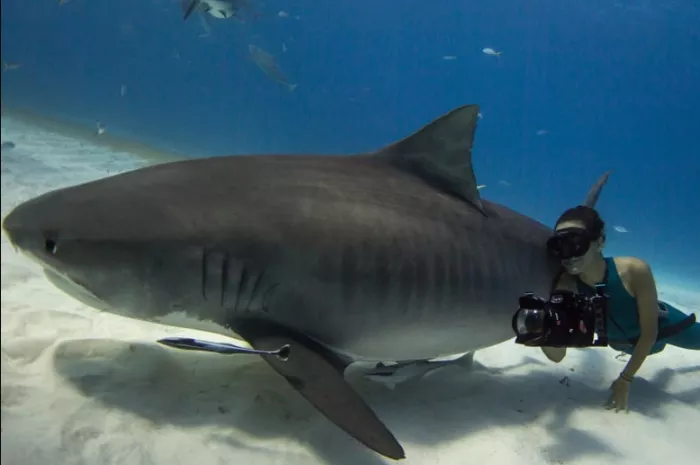A shocking video capturing a near-fatal shark attack has raised serious concerns about the growing trend of shark diving, particularly in popular tourist destinations. In the footage, a diver is seen floating in murky waters when a massive 15-foot Tiger shark unexpectedly approaches from behind, nearly striking the diver’s head. While the diver survived with only minor injuries and a few stitches, the harrowing encounter serves as a stark reminder of the dangers involved in unregulated shark tourism.
We spoke with Madison Stewart, an experienced shark diver and advocate for marine conservation, to gain insight into the rising risks and what the public needs to know about safe shark diving practices.
The Incident: What Went Wrong?
The video, which has since gone viral, shows a diver who appears to be alone in the water when the Tiger shark—an apex predator known for its ambush hunting techniques—comes dangerously close. The shark briefly nudges the diver’s head and equipment before swimming away. Stewart, who has over 16 years of experience diving with sharks, labeled the situation as “extremely dangerous” and noted the diver’s lack of proper safety protocols.
“The diver was alone, which is a major red flag. Eye contact is crucial when diving with sharks, and this individual had no one to watch their back,” said Stewart. “Had the shark been more interested, it could have easily been fatal.”
Stewart explained that the increasing popularity of shark diving, fueled in part by social media, has led to more untrained individuals entering the water with dangerous predators without fully understanding the risks involved.
The Shift in Shark Diving Culture
According to Stewart, the surge in unregulated shark diving operations over the last 15 years has contributed to a growing disregard for established safety protocols. “The reality is, many divers today are chasing social media fame, not focusing on the well-being of the sharks or their own safety,” she explained. “Sharks should never be treated as props for a photo op. These animals are unpredictable, and we need to show them the respect they deserve.”
While Stewart believes that shark tourism can have positive impacts on conservation efforts, she stressed the importance of diving with experienced operators who prioritize safety. In the case of the Maldives incident, Stewart pointed out that a reputable dive operator would have removed the divers from the water immediately upon encountering a Tiger shark.
“I’ve dived at that site before with a reputable operator, and we didn’t take our eyes off the shark. The difference between safe and unsafe practices is staggering,” she added.
The State of Shark Tourism: Growing Popularity, Rising Risks
Stewart also raised concerns about the lack of regulations governing shark diving worldwide. “There are countless dive operations out there with little to no oversight,” she noted. “It’s one thing to be a beginner diver, but it’s entirely another to claim to be a guide without proper training in both safety and shark behavior.”
The rapid rise of social media-driven tourism has exacerbated the problem, Stewart said. Many shark diving businesses are more focused on profits than on providing a safe, educational experience. This trend has led to situations where unqualified individuals are guiding clients into dangerous waters.
How to Choose a Safe Shark Diving Operation
Despite the risks, Stewart emphasized that shark diving can be a force for good, provided that proper safety measures are in place. For those interested in shark tourism, she offered advice on how to identify a responsible operator.
“Start by asking questions. A good operator will prioritize your safety and provide clear, thorough guidelines,” she advised. “They should be able to answer your questions about the dive site, the sharks in the area, and the risks involved. Don’t be swayed by flashy social media posts—look for certifications and reviews from experienced divers.”
Stewart also recommended doing thorough research before booking a dive, stressing the importance of learning from trusted sources. For surfers, she added, diving with sharks can be an enlightening experience that helps demystify these misunderstood creatures.
“If you’re in the water regularly, especially as a surfer, it’s valuable to get a deeper understanding of the sharks that share those waters with you,” Stewart said. “But remember, it will never be 100% risk-free. However, with proper training and precautions, it’s far safer than the drive to the dive site.”
The Future of Shark Diving: Safety First
In an effort to promote safer shark diving practices, Stewart has committed to raising awareness about the need for more stringent regulations in the industry. She encourages those interested in shark tourism to be cautious and to seek out organizations that are dedicated to both shark conservation and diver safety.
As part of her ongoing advocacy work, Stewart will continue to provide resources and information on shark safety. “Shark diving can change how people view these animals, but it has to be done responsibly,” she said. “The goal is to protect sharks while also ensuring that divers stay safe.”
Related topics
- Watersports Wetsuit Market Set to Reach USD XX.X Billion by 2031
- Sports Medicine Devices Market to Reach $11 Billion by 2028
- Board of the World Launches Tool to Simplify Snowboard Shopping

